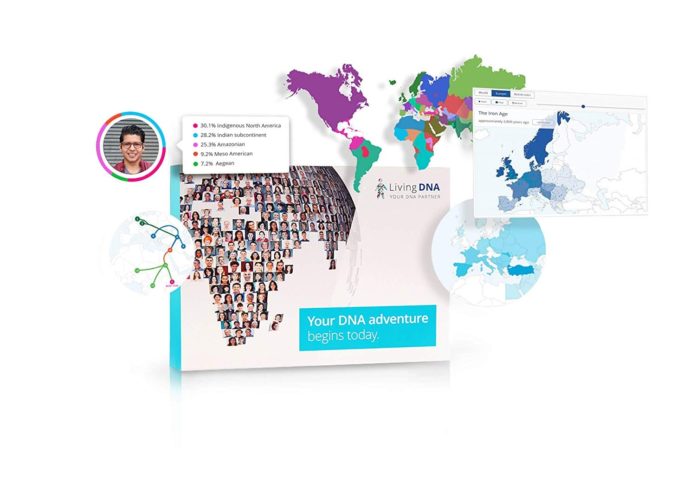DNA ancestry tests are one of the more recent intricacies offered by modern science and biology. That doesn’t mean that the industry is still in its infancy, however. DNA testing companies these days have thorough tests to determine your ancestry dating up to 10,000 years in the past, with a fairly accurate guess of the lineage of the last 5-10 generations. We’ve already reviewed MyHeritageDNA which is a basic autosomal test and when it comes to detail leaves a lot to be desired. This time we went with Living DNA that provides all three tests: autosomal, yDNA and mtDNA in one package for a total price of $99. It ships globally via post and unlike its competitors also comes with a prepaid return parcel.
DNA tests: Autosomal, yDNA and mtDNA
There are mainly three types of DNA test: Autosomal, Y

Most companies rely on Autosomal DNA testing which can be used to track your ancestors who lived some 500-1000 years in the past. These include
When looking for a DNA test kit, other than the price there are two things you need to keep in mind. Firstly, the accuracy of a company’s tests will depend directly on its database count. The higher the figure, the more accurate the results. Secondly,
Kit Contents
Within the DNA kit, you’ll find the following:
- DNA Swab and Tube
- Instructions
- Return envelop
Taking a DNA sample is pretty straightforward. LivingDNA’s 2-in-1 swab and tube container

Be sure not to be too firm, or you might include some blood in the sample, effectively ruining it. After taking the sample, close the vial (with a clicky sound) and paste the bar-code on it. Then enclose it in the envelope and off to the post office.
You’re not required to pay any postage and your country’s registered postal service should take care of the return. Before you send it back, make sure to take a snapshot of the specimen bag as it contains the code needed to activate your DNA kit online and view the results when it’s time.
DNA Results: What Makes You, You
It takes approximately 2-3 months for the results to arrive after they reach the lab in Europe. Comparatively,
Autosomal DNA Ancestry: Here you’re going to find your ancestry tracked via 22 chromosomes, and gives a fairly accurate reading of up to 10 generations. LivingDNA’s results contain two main sections in this section, namely the family ancestry map and a rough estimate of your ancestry through history. Let’s dig in, shall we:
Your Ancestry Through History

The official documentation says that this map is designed to show the geographical location and the concentration of your common ancestors’ descendants from that point in history. Basically, it’s a breakdown of where your relatives lived as time passed by. It goes back as far as 60-80K years, but of course, there’s a lot of guess-work involved when you are comparing your DNA with people from the Ice Age.
Family Ancestry Map
Unlike most DNA testing companies, LivingDNA goes a step ahead and provides sub-divisions in the ethnicity map. You get three versions: Complete, standard and cautious. As per the company’s founder, David Nicholson:
The Cautious view results show the ancestry estimations in a more conservative way, by grouping smaller regions into larger shapes to indicate that if we are being ‘cautious’, we can say that the original assignments from the Complete view may be covering ancestry from a border region.

For example, in the standard view, I got, Asia South (77%), South-West China (3%) and Near East (19.7%). However, in the cautious view, I got five regions: 56% South Central Asia, 35% South-Asia, 6% Middle East and 3% South East Asia-related ancestry.

Furthermore, the Central Asian ancestry which forms the majority of the percentage is divided into three ethnicities: Kurdish, Persian/Iranian and Pashtu. There’s a detailed explanation of each population given alongside which makes for an interesting read and helps you join the dots.

There’s a breakdown of the main populations into sub-regions but these aren’t 100% accurate and may vary as many of them are similar to each other, thereby the cautious estimate.

Motherline and Fatherline:
For both the
Phylogenetic Tree

The phylogenetic tree shows your position within the mtDNA evolutionary tree of life. At the top of the tree is the root group that every living person today can trace their ancestry to.
As you work your way down the tree, different people take different branches. Major groups are considered haplogroups and at the very last level, we have my subtype- C4.
Migration Map

The migration map shows the path your ancient ancestors traced as they spread out across the globe. The start of the journey is taken from a point in history when it’s theorized that we all shared the same mtDNA and each color change represents a variation in that mtDNA. This gave rise to the different Maternal Haplogroups we have today.
Coverage Map

The
Lastly Some History

Both the
Conclusion: One of the Best DNA Kits Out There
I was actually quite impressed by the sheer amount of detail that LivingDNA provides with its results: history, haplogroups, trees and of course the ethnicity map. On top of this, you get this for just $99. There’s only one flaw, namely, LD can’t help you find DNA matches within its database…just yet (it’s in beta stage). However, fret not you can always use GEDmatch to find possible, long-lost cousins (it’s free).
Further Reading: http://wordpress-695532-2297746.cloudwaysapps.com/does-your-body-really-replace-itself-every-seven-years/


